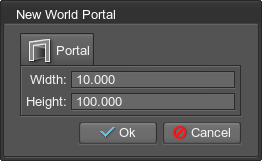Portal
A portal is a rectangular opening between two adjacent sectors, through which one sector can be partially seen if looking from another.

A Portal between Sectors
See also
- WorldPortal class to edit portals via UnigineScript
Creating a Portal
To create a portal, choose the Add World Portal option in the list of nodes of Editor panel. In the opened creation dialog window specify initial parameters:

A Creation Window
| Width | The width of the portal's rectangular, in units. |
|---|---|
| Height | The height of the portal's rectangular, in units. |
After the initial parameters are set, click Ok and place the portal somewhere in the world.
Editing a Portal
In the Portal tab you can adjust the following parameters of the portal:

A Portal tab
Bounding Box Parameters
A set of bounding box parameters:
| Width | The width of the portal's rectangular, in units. |
|---|---|
| Height | The height of the portal's rectangular, in units. |
Last update: 03.07.2017
Помогите сделать статью лучше
Была ли эта статья полезной?
(или выберите слово/фразу и нажмите Ctrl+Enter